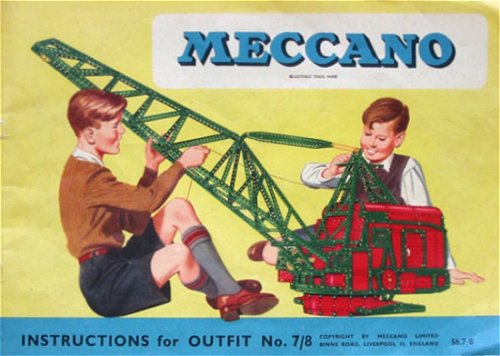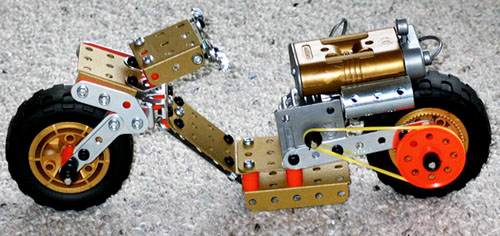Frank Hornby
Today, arts, crafts and Meccano sets. The University of Houston's College of Engineering presents this series about the machines that make our civilization run, and the people whose ingenuity created them.
Arts and Crafts were everyone's passion as we entered the 20th century. Industrialization was blanketing the known world and we struggle to keep some of what we were losing. And yet, those arts an crafts rapidly took on the texture of the very world they were trying to keep at bay. Take the case of Frank Hornby:
Hornby was born in Liverpool in 1863. He left school at sixteen to work as a shipping clerk in his father's supply business. Then he married, and when he had children, began making toys for them. Well, not toys, but parts from which they could build their own toys. He cut metal strips with rows of holes for bolts. He added wheels, shafts, pulleys. (If you're old enough, you'll see what he was up to.)
Hornby had, perhaps unwittingly, tied into two major impulses at once. One was the rising fascination with arts and crafts. The other was every child's creative curiosity ... "If I screw these pieces together like this, then put a crank on this pulley here, I'll have a machine to haul my blocks from here to there."
By 1901, he'd realized he could make and sell boxed sets of such parts. He gave them the catchy na me, Improvements in Toy or Education Devices for Children and Young People. The sets were endorsed by a famous engineer at the University of Liverpool, Henry Selby Hele-Shaw. By 1903, Hornby had trimmed the name to Mechanics Made Easy, and his sales were outrunning the supplier's ability to keep up.
me, Improvements in Toy or Education Devices for Children and Young People. The sets were endorsed by a famous engineer at the University of Liverpool, Henry Selby Hele-Shaw. By 1903, Hornby had trimmed the name to Mechanics Made Easy, and his sales were outrunning the supplier's ability to keep up.
Four years later, Hornby had his own company and a new name. These were now Meccano sets, and they are so even today. Here in America, we older people remember building not Meccano, but Erector, sets. A. C. Gilbert began selling Erector sets in 1913. By the mid-'30s they, along with Gilbert's chemistry sets, and more, were teaching us all abut the wonders of technology and science.
The first Meccano and Erector sets provided spring-driven motors. By the time I was building with them, they included a small electric motor. That motor had open wiring so we could see how it worked. The sets also had a screwdriver and a small wrench, since we had to bolt everything together.
That finally yielded to simper assembly. Tinker Toys had been competing with them all along. Then, in 1958, the modern Lego block was released. Erector sets went out of business nine years later. But -- not to fear -- you can still buy one; it's now made by a Japanese company operating in France. And that company is none other than Meccano!
Frank Hornby became rich. He even did an undistinguished stint in the House of Commons before he died in 1936. More important, he had, by then, started yet another industry: A series of scale model cars -- the so-called Dinky Toys. They were overtaken by America's Matchbox cars. But Hornby's first legacy, his Meccanosets have somehow survived all the way into this brave new world of the third Millennium.
I'm John Lienhard, at the University of Houston, where we're interested in the way inventive minds work.
Hornby, F. (1863-1936) The Oxford Dictionary of National Biography, Vol. 6, pp. 124-124. See also the Wikipedia entry on Hornby.
See also, the Wikipedia entries for Meccano sets and Erector sets.
C. Gibson, A History of British Dinky Toys. (London: Model Aeronautical Press,Ltd., 1966). See also the Wikipedia entries on both Dinky Toys and Matchbox Toys.


Above, a vintage Meccano set. Below, a motorcycle model build from a modern Meccano set. (These images courtesy of Wikipedia, Tinker Toy photo by JHL)